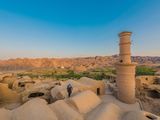what became available to europe due to the silk road
The Silk Road is neither an actual road nor a single route. The term instead refers to a network of routes used past traders for more 1,500 years, from when the Han dynasty of People's republic of china opened trade in 130 B.C.Due east. until 1453 C.Due east., when the Ottoman Empire airtight off trade with the W. German geographer and traveler Ferdinand von Richthofen first used the term "silk route" in 1877 C.E. to describe the well-traveled pathway of goods between Europe and East Asia. The term also serves as a metaphor for the exchange of goods and ideas between various cultures. Although the merchandise network is commonly referred to as the Silk Road, some historians favor the term Silk Routes considering it better reflects the many paths taken past traders. The Silk Route extended approximately half-dozen,437 kilometers (4,000 miles) across some of the globe's most formidable landscapes, including the Gobi Desert and the Pamir Mountains. With no one government to provide upkeep, the roads were typically in poor condition. Robbers were mutual. To protect themselves, traders joined together in caravans with camels or other pack animals. Over fourth dimension, large inns chosen caravanserais cropped up to house travelling merchants. Few people traveled the entire route, giving rise to a host of middlemen and trading posts along the way. An abundance of appurtenances traveled along the Silk Road. Merchants carried silk from China to Europe, where it dressed royalty and wealthy patrons. Other favorite commodities from Asia included jade and other precious stones, porcelain, tea, and spices. In exchange, horses, glassware, textiles, and manufactured goods traveled due east. 1 of the most famous travelers of the Silk Road was Marco Polo (1254 C.Eastward. –1324 C.Eastward.). Born into a family of wealthy merchants in Venice, Italy, Marco traveled with his father to China (then Cathay) when he was just 17 years of age. They traveled for over three years before arriving at Kublai Khan'due south palace at Xanadu in 1275 C.E. Marco stayed on at Khan'south court and was sent on missions to parts of Asia never before visited by Europeans. Upon his return, Marco Polo wrote nigh his adventures, making him—and the routes he traveled—famous. It is hard to overstate the importance of the Silk Road on history. Religion and ideas spread along the Silk Road just as fluidly as appurtenances. Towns forth the route grew into multicultural cities. The substitution of information gave rising to new technologies and innovations that would change the world. The horses introduced to China contributed to the might of the Mongol Empire, while gunpowder from China changed the very nature of war in Europe and beyond. Diseases also traveled along the Silk Road. Some research suggests that the Black Death, which devastated Europe in the belatedly 1340s C.E., probable spread from Asia along the Silk Road. The Age of Exploration gave rise to faster routes between the E and W, but parts of the Silk Road continued to be critical pathways among varied cultures. Today, parts of the Silk Road are listed on UNESCO'southward Globe Heritage List.

A tourist looks around the aboriginal metropolis of Kharanaq, Iran. Towns such as these played a crucial role in the performance and success of the Silk Road.
Photo by Mekdet
Age of Exploration
Substantive
(1400s-1800s) flow during which Europeans traveled the earth by ocean in search of trade.
Black Death
Noun
(1345-1400) plague that devastated Europe, killing a quarter of the population.
caravan
Substantive
grouping of people who travel together for safe and companionship through hard territory.
Noun
inn with a central courtyard frequently institute in the desert that served travelers forth the Silk Route in Asia and Due north Africa
metaphor
Noun
give-and-take or phrase used to correspond something else, or an understanding of one concept in terms of another concept.
silk
Noun
soft, stiff fiber spun by some moth larvae, spiders, and other animals.
material
Noun
fabric or other woven material.
merchandise route
Noun
path followed past merchants or explorers to commutation appurtenances and services.
Noun
the United nations Educational, Scientific, and Cultural Organisation.
Source: https://www.nationalgeographic.org/encyclopedia/silk-road/
0 Response to "what became available to europe due to the silk road"
Post a Comment